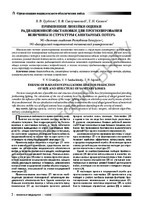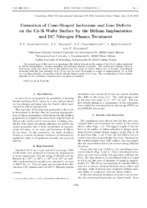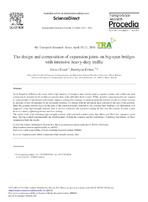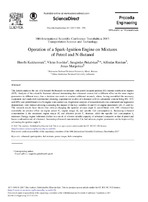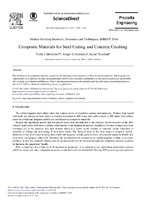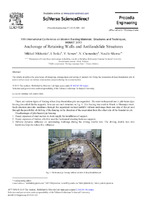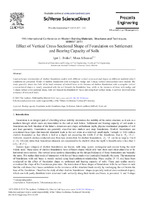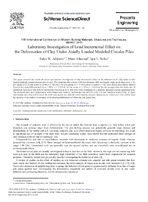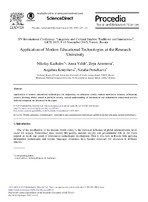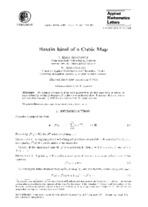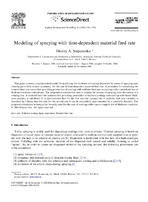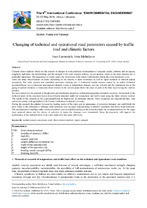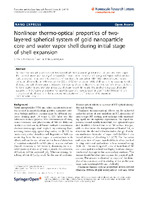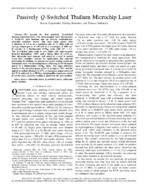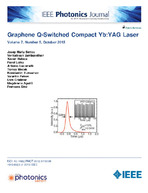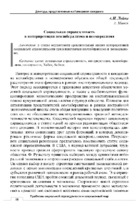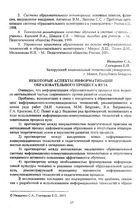Внеуниверситетские публикации ученых БНТУ: Recent submissions
Now showing items 2621-2640 of 4615
-
Применение линейки оценки радиационной обстановки для прогнозирования величины и структуры санитарных потерь
(БГМУ, 2018)Максимально точное прогнозирование возможных величины и структуры санитарных потерь является основой для планирования медицинского обеспечения предстоящих боевых действий. Расчет величины санитарных потерь в зависимости от количества предполагаемых общих потерь учитывает влияние основных условий боевой деятельности войск, в которых они возникают и которыми определяются. Использование ...2018-03-12 -
Развитие художественно-эстетических потребностей студентов университета
(Гомельский государственный университет имени Ф. Скорины, 2013)В статье обсуждается актуальная проблема формирования нравственной позиции и художественно-эстетических потребностей студентов университета. Рассматриваются теоретические основы становления культурного отношения человека к действительности, выделяются функции искусства в духовно-нравственном развитии социума, анализируются практические результаты исследования художественно-эстетических ...2018-03-12 -
Formation of Cone-Shaped Inclusions and Line Defects on the Cz-Si Wafer Surface by the Helium Implantation and DC Nitrogen Plasma Treatment
(2011)The general goal of this work is to investigate the defects formed on the surface of the Cz-Si wafers subjected to helium implantation, vacuum annealing and nitrogen plasma treatment. The performed scanning electron microscopy study has shown that in the general case two types of surface defects can be formed: cone-shaped inclusions with the base diameter of 0.2-2 mu m and the ...2018-03-10 -
The design and composition of expansion joints on big-span bridges with intensive heavy-duty traffic
(2016)In the Republic of Belarus the roads with a high intensity of transport most widely employ expansion joints with rubber and steel compensators fastened to the reinforced concrete base with embedded therein studs. While operated expansion joints are exposed to various kinds of operational and climatic impacts causing their damage. Expansion joints destruction results in a sharp ...2018-03-10 -
Operation of a Spark-Ignition Engine on Mixtures of Petrol and N-Butanol
(2017)The Article analyses the use of n-butanol (biobutanol) in mixtures with petrol in spark-ignition (SI) internal combustion engines (ICE). Analysis of the scientific literature allowed determining that n-butanol content had a different effect on the same engine parameters in different tests, thus a decision was made to conduct additional research, where, having assembled the necessary ...2018-03-10 -
Composite Materials for Steel Cutting and Concrete Crushing
(2017)The steel based on composite material, created by the stitching of steel matrix by a flow of powder particles. Stitching process implemented in conditions of super deep penetration (SDP) which provides a penetration of the powder particles at speed 1000 m/s on depth up to hundred millimeters. Due to the interaction between the particles and the steel matrix at pulsating pressureabove ...2018-03-10 -
Anchorage of Retaining Walls and Antilandslide Structures
(2013)The article describes the experience of designing, arrangement and testing of anchors for fixing the protection of deep foundation pits in narrow urban areas on various construction projects during the reconstruction.2018-03-10 -
Effect of Vertical Cross-Sectional Shape of Foundation on Settlement and Bearing Capacity of Soils
(2013)Load-settlement relationships of shallow foundation models with different vertical cross-sectional shapes on different modeled subsoil conditions are presented. Model of shallow foundations with rectangular, wedge and T-shape vertical cross-sections were studied. The study generally shows that bulk of the load resistance of subsoil bases at the instance of shallow foundations ...2018-03-10 -
Laboratory Investigation of Load Incremental Effect on the Deformation of Clay Under Axially Loaded Modeled Circular Piles
(2013)This paper presents the results of recent experimental investigation of load incremental effect on the deformation of clay under axially loaded modeled wooden circular piles in clay. The modeled piles consist of 20 mm diameter, 200 mm length, made up of single pile, 4 No pile group of 2x2 with centre to centre a = 4d, and 9 No pile group of 3x3 with centre to centre a = 3d, were ...2018-03-10 -
Application of Modern Educational Technologies at the Research University
(2015)Application of modern educational technologies for diagnosing set education results, student motivation increase, influencing creative thinking ability aimed at problem solving, critical understanding of information and independent educational activity skills development are discussed in the paper.2018-03-10 -
Bautin ideal of a cubic map
(2001)We compute the radical of the ideal generated by the first three focus quantities of maps defined by irreducible branches of a cubic curve on the real plane. It is shown that the ideal is not radical in this case.2018-03-10 -
Modeling of spraying with time-dependent material feed rate
(2007)This paper presents a mathematical model for predicting the thickness of coatings deposited by means of spraying onto rotating parts with circular symmetry, for the case of time-dependent material feed rate. A procedure for calculating the material feed rate control law providing production of coatings with uniform thickness or coatings with a predefined law of thickness variation ...2018-03-10 -
Changing of technical and operational road parameters caused by traffic load and climatic factors
(2014)Climatic factors and car wheels are the reasons of changes in road condition: deformations of subgrade, cracks, potholes and rut appear, roughness and safety are deteriorating, and the strength of the road structure reduces. In our opinion, cracks in the road structure are of particular importance. The appearance of cracks causes the destruction of the whole road structure during ...2018-03-10 -
Nonlinear thermo-optical properties of two-layered spherical system of gold nanoparticle core and water vapor shell during initial stage of shell expansion
(2011)Nonlinear thermo-optical properties of two-layered spherical system of gold nanoparticle core and water vapor shell, created under laser heating of nanoparticle in water, were theoretically investigated. Vapor shell expansion leads to decreasing up to one to two orders of magnitude in comparison with initial values of scattering and extinction of the radiation with wavelengths ...2018-03-06 -
Passively Q-Switched Thulium Microchip Laser
(2016)We present the first passively Q-switched thulium microchip laser. The diode-pumped laser incorporates a Tm:KYW gain medium and an InGaAs semiconductor saturable absorber mirror. The laser emits pulses with a duration of 2.4 ns at a repetition rate of 1.2 MHz with an average output power of 130 mW at a wavelength of 1905 nm. It operates in a fundamental TEM00 mode with M2 < 1.1. ...2018-03-06 -
Graphene Q-Switched Compact Yb: YAG Laser
(2015)We describe a compact Yb: YAG laser Q-switched by a graphene-based saturable absorber and pumped by a laser diode at 932 or 969 nm. The compact laser generates a maximum average output power value of 185 mW at 1032 nm with a slope efficiency value of 12%. The shortest duration of the Q-switched pulse achieved is 228 ns at a repetition frequency of 285 kHz. The maximum pulse energy ...2018-03-06 -
Modern trends in improvement of steel heating technology in continuous furnaces
(2016)The principles and approaches in the development and improvement of steel heating technology in the furnaces of rolling manufacture of various structural design, based on the systematic study of thermal physical and technological processes, including mathematical modeling, industrial experiments, development of rational temperature-thermal modes.2018-02-27 -
Compact 0.7 mJ/11 ns eye-safe erbium laser
(2016)We report on the development of a compact diode-end-pumped eye-safe (similar to 1.54 mu m) passively-cooled Er, Yb:glass laser. The design of this laser is facilitated by the use of a double-pass pumping scheme and a special ZrO2 diffuse reflector for a uniform pump distribution. In the free-running mode, this laser generates 8.2 mJ/3 ms pulses with a slope efficiency of 15%. ...2018-02-27 -
Социальная справедливость в интерпретации неолиберализма и неомарксизма
(Череповецкий государственный университет, 2015)В статье осуществлен сравнительный анализ интерпретаций социальной справедливости представителями неолиберализма и неомарксизма.2018-02-22 -
Некоторые аспекты информатизации образовательного процесса вуза
(Стерлитамакский филиал Башкирского государственного университета, 2015)Иващенко, С. А. Некоторые аспекты информатизации образовательного процесса вуза / С. А. Иващенко, Е. П. Гончарова // Актуальные психолого-педагогические проблемы профессиональной подготовки : сборник научных трудов по материалам XII международной научно-практической конференции (Стерлитамак, 27 марта 2015 г.). – Стерлитамак, 2015. – С. 17-20.2018-02-21

